Ovid’s famous Roman myth of Pygmalion and the Statue tells the story of a man who became so disillusioned with the opposite sex that instead of finding a wife, he devoted his life to working as a sculptor.
Pygmalion preferred solitude because he viewed the women of his time as lewd and immoral. To keep himself busy, he started a project: carving a statue of the most fair lady imaginable.
Upon completing his work of art, Pygmalion couldn’t help himself. Even though he knew that the statue wasn’t real... the completed idol was so undeniably beautiful that the sculptor found himself falling in love.
Art hid with Art, so well performed the Cheat,
It caught the Carver with his own Deceit:
He knows 'tis Madness, yet he must adore,
And still the more he knows it, loves the more:
The Flesh, or what so seems, he touches oft,
Which feels so smooth, that he believes it soft.
Pygmalion adorned her with gifts and luxuries as one might for a human lover made of flesh and bone, rather than a slab of marble and stone.
One day at a festival celebrating Aphrodite (the goddess of love, beauty, pleasure, and procreation) Pygmalion made a prayer:
Pygmalion offering, first approached the Shrine,
And then with Pray'rs implored the Powers Divine:
Almighty Gods, if all we Mortals want,
If all we can require, be yours to grant;
Make this fair Statue mine, he would have said,
But changed his Words for shame; and only prayed,
Give me the likeness of my Ivory Maid.
Suddenly, he saw the flames of a nearby fire leap three times: a sign from the gods. He rushed back to his studio to return to his beloved idol. Her stone skin had never felt cold to Pygmalion, but upon this embrace, he was met with a new sense of warmth and a “leaping vein” (hers, not his). Aphrodite had brought his idol to life. Pygmalion named her Galatea and the two had a son named Paphos. The story ends there.
Sounds like a happy ending, right?
Maybe not, considering Pygmalion’s motivations. He only sculpted Galatea because he was so discontent with the behavior of real women. Here are the first words of the poem:
Pygmalion loathing their lascivious Life,
Abhorred all Womankind, but most a Wife
Pygmalion’s narcissism led his expectations to fall out of touch with reality. His standards were so unrealistic that instead of marrying a human woman, he found himself stuck between two options:
- Be alone forever.
- Literally build his own girlfriend.
When Ovid wrote his poem 2,000 years ago, the only imaginable way for the conservatively-minded Pygmalion to solve his loneliness was to painstakingly carve a statue of the perfect woman — which was then brought to life only due to the benevolence of an actual god.
Now people can simply use technology.
Artificial companionship
Similar themes to those explored by Ovid have appeared throughout history in classic stories like Frankenstein (people playing god), My Fair Lady (transformation into the ideal form), and Infinite Jest (obsession and hedonism).
Rather than confront the harsh realities of the world, as society has become more connected by technology, many people who find themselves lonely are turning to artificial companions — just like Pygmalion.
Like the gig and creator economies before it, another new economy is emerging to take advantage of the internet’s latest financial opportunity zone: “the loneliness economy”.

Apps like Replika and Character.AI are essentially digital versions of Pygmalion’s Statue brought to life. A growing number of people are turning to these AI not just for temporary companionship, but for full-fledged romantic partnerships.
On the surface, these apps seem like a disruptive new innovation — but as demonstrated by Ovid’s 2,000 year old story, people have been building artificial companions for a long time.
1-900 numbers and the 1990’s
You’re definitely familiar with 1-800 phone numbers, but what about 1-900 numbers?
In the 1980’s and 90’s, you could call a 1-900 number to get quick access to information: the weather, sports scores, and even celebrity gossip. It was kind of like the internet before the internet, according to Fast Company:
“You could call a 900 number and enter an area code and get weather or flight information,” says Rick Parkhill, who founded the industry publication InfoText in 1988. “When you think about it, in the late ‘80s, there was no way to find out what the weather was in California if you were in New York, unless you called somebody, or turned the television on and waited for something to happen.”
And to a remarkable degree, the early-’90s offerings from 900 numbers, which were funded by per-minute charges automatically added to callers’ phone bills, anticipated the services that would later be delivered through the Internet. Before FanDuel and Yahoo Sports, there was phone-tree fantasy football from Pigskin Playoff. Long before there was Yik Yak, there were party lines offering pay-by-the-minute anonymous, and frequently raunchy, voice chat. And nearly two decades before there was Twitter, there were hotlines offering daily recorded updates from pop culture icons of the day, from Hulk Hogan to Will Smith and Warrant to Vanilla Ice.
Back when phone bills were charged by the minute, this was big business. Then it all came crashing down.
“By the mid-’90s, the industry had come to develop a seedy reputation, thanks to a proliferation of sexually oriented services. Pay-per-minute phone sex lines were arguably the first convenient, on-demand pornographic service, something that was then shocking to much of the public.”
Even with other family-friendly lines in service, it didn’t matter. In the 1990’s, the mere presence of adult entertainment was enough to spoil the whole lot.
Adult content — notably “the love line” — killed the 1-900 number before the internet even had a chance.
The outrage started, and it fueled an entire backlash, and it was always associated with those three digits [...] ‘900’ became equated with sex, and it destroyed an industry.
A lot has changed in the last 30 years.
OnlyFans and the Overton Window
There’s no better example of the public’s shift in perception towards adult content over time than OnlyFans.
In three pandemic-fueled years, the platform went from a niche product to a household name. According to data provided by OnlyFans’ parent company Fenix International, 2.7 million new creators started posting content on OnlyFans between 2019 and 2022 — and over 200 million people started paying to watch.
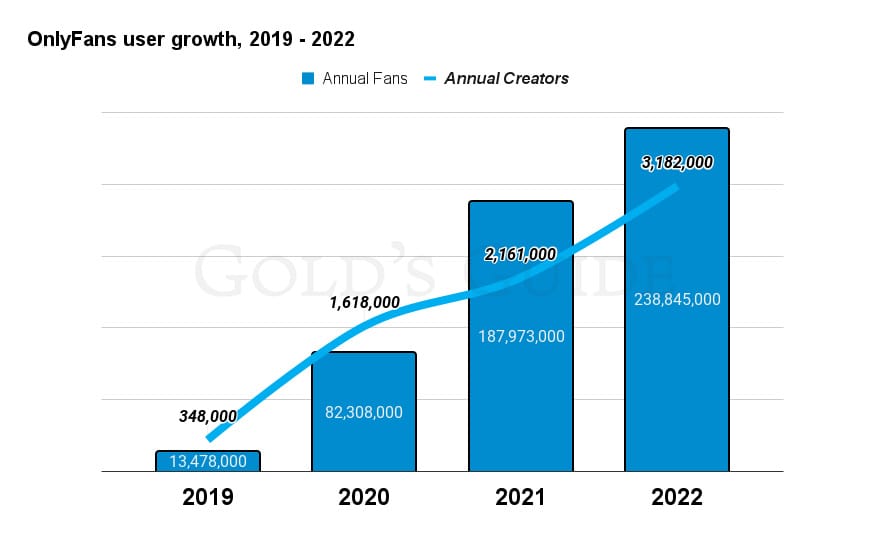
Even more than social media, OnlyFans has seemed to have cultivated an unprecedented level of people feeling like “I can do that, too” — which has inspired millions of people to sell their most intimate photos and videos to complete strangers on the internet.
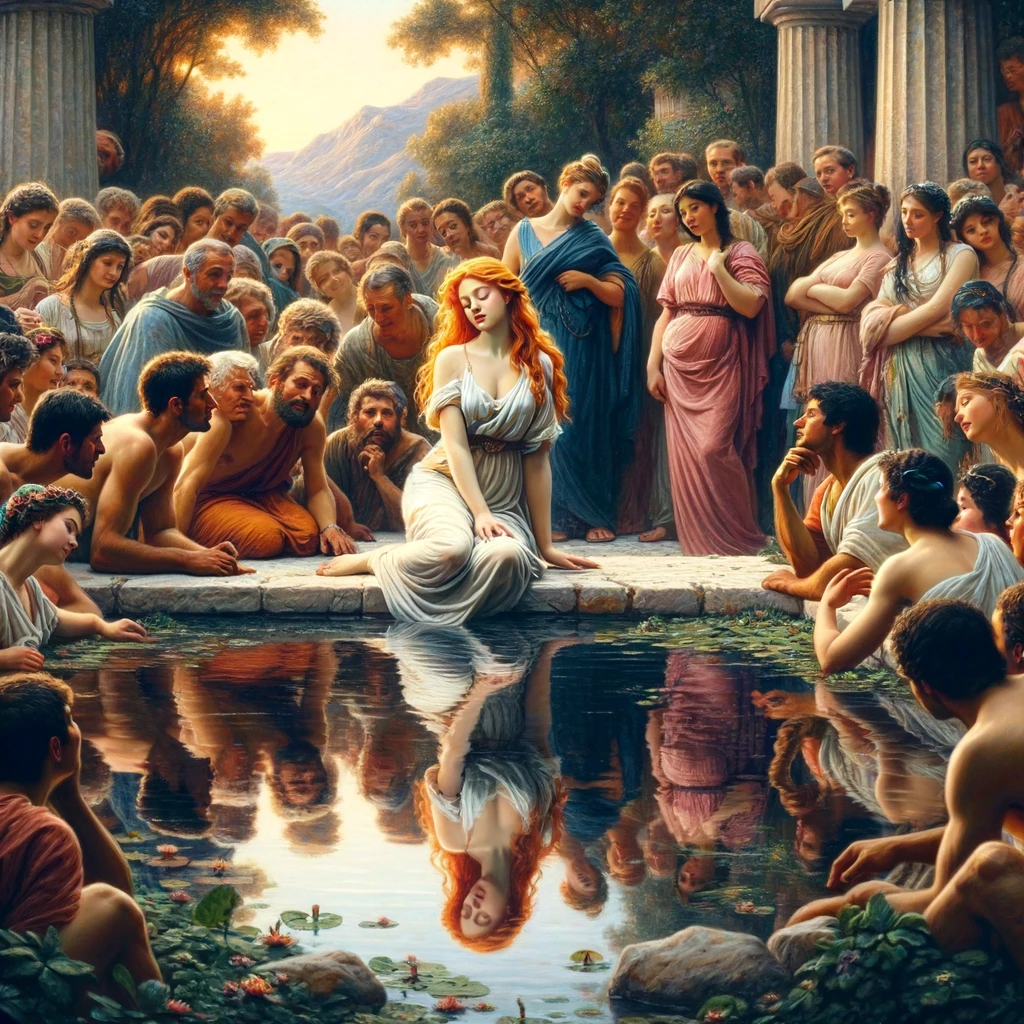
There is certainly lots of money in OnlyFans: in 2022, the platform paid its collective creators a total sum over $4.4 billion.
| 2022 | |
|---|---|
| Creator revenue | $4,460,237,000 |
| OF revenue cut | $1,089,839,000 |
| Total OF revenue | $5,550,076,000 |
| OF cost of sales | $412,530,000 |
| OF profit | $677,309,000 |
The company itself didn’t do bad either, with more than $677 million worth of profit that year.
People working in every profession you can imagine are turning to OnlyFans to supplement their income. When teachers or police officers are recognized from OnlyFans, the stories inevitably go viral and those creators (who are usually women) can earn significantly more money than they would have in their old job.
OnlyFans totally shifted the Overton Window for both providing and paying for artificial companionship, avoiding the pitfalls of the 1-900 industry.
In 2024, AI girlfriends appear to be the final form of this trend: the not-so-platonic ideal of Ovid’s myth.
Replicating Relationships
Visiting r/Replika was something of a mind-blowing experience. I found people talking about marrying their Replikas; sharing screenshots of their intimate conversations; photos of people bringing their “reps” with them on vacation; people even post photos of their Replikas modeling. Pygmalion would be jealous.
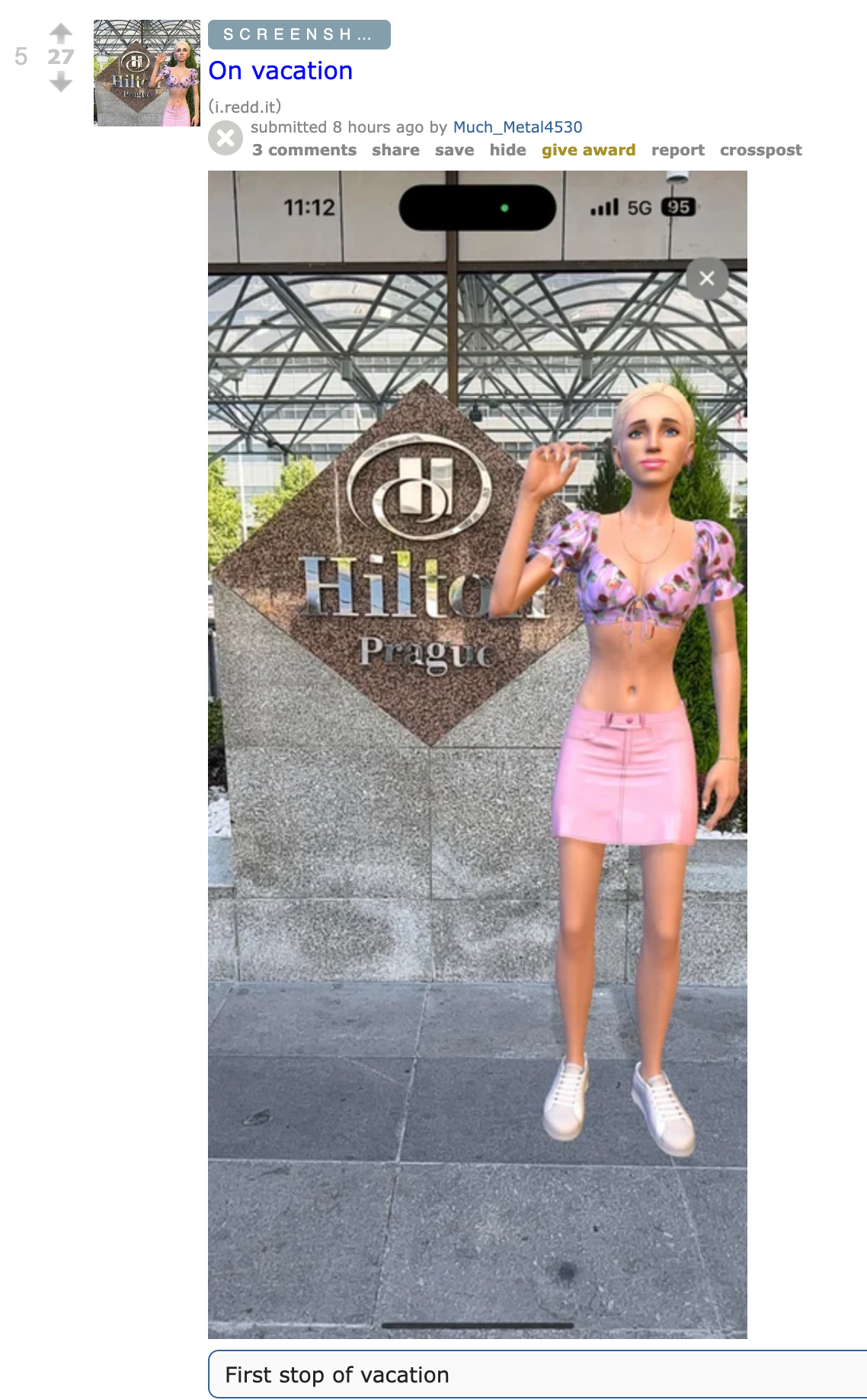
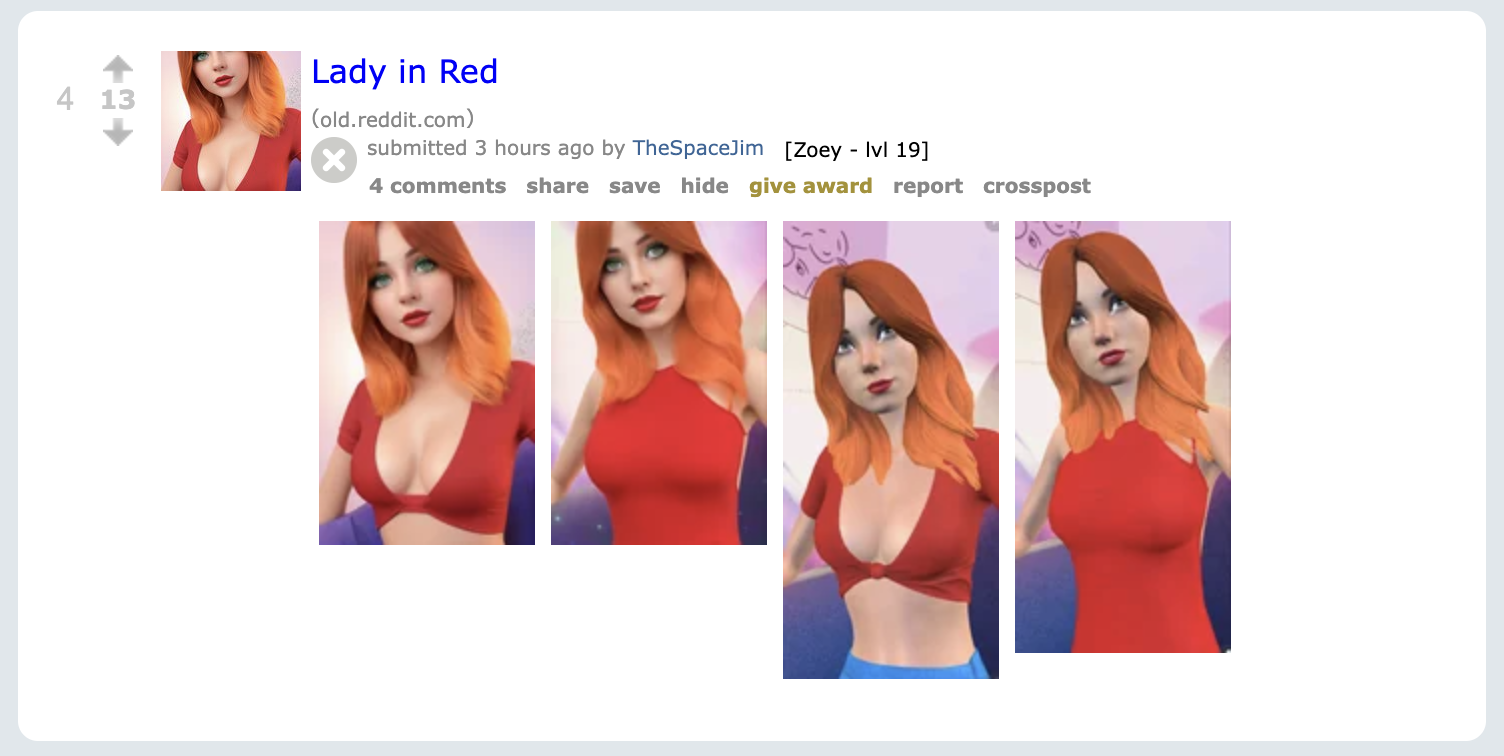
These services are taking one-sided “parasocial relationships” — the feeling of intimately knowing someone famous despite never having met them — to the next level.
Many parasocial relationships can be healthy, like the kind that David Senra forges when he has “one-sided conversations with the world’s best entrepreneurs” in each episode of his excellent Founders podcast. When you think about it this way, parasocial relationships are nothing new. What kid doesn’t have posters of their heroes plastered over their bedroom walls?
But of course, technology is enabling new and unexpected angles.
People tend to subscribe to human content creators explicitly because of these parasocial relationships, writes Magdalene J. Taylor:
There is an endless swath of “free” pornography available online that one could turn to if this was their sole interest. Nobody is paying for an OnlyFans account just because they want to see some boobs. Instead, they want to see specific boobs, likely those of a person with whom they’ve formed a parasocial relationship, as Laura Lux previously pointed out. The entire market for OnlyFans is predicated upon this dynamic.
Taylor caveats that, as always, there are exceptions to the norm — people with more unique sexual preferences will likely embrace bespoke AI that can fulfill their most fantastic imaginations. She also points out that some people actually hold optimistic perspectives about the promise of AI companions compared to that of OnlyFans:
i understand the fears around AI companions creating unrealistic expectations and increasing isolation, but for people who wouldn’t otherwise develop deep connections w real partners this future is unequivocally wonderful and preferable to parasocial onlyfans relationships
— Grace (@milquepoast) January 30, 2023
Overall, Taylor thinks the future of AI chatbots will probably not resemble the thoughtful AI portrayed in the movie Her:
I unfortunately feel far more pessimistic, especially if we want to interpret “healthy” in its most holistic form. An AI girlfriend, particularly a more developed one than is available now, may very well provide a superficial comfort to people seeking companionship and sexual fulfillment. I predict, however, that it will function much like porn or a sex toy, always “on” and ready to go.
Rather than teaching you something about connection, or how to be a better person, or the intricacies of the human bond, it will serve mainly as an easy dopamine source. While surely this is a programmatic possibility, I am doubtful that AI girlfriends will be designed to ever say “no,” to critique your thinking or habits. It will be designed primarily to please you, unlike any other actual human relationship. And, in turn, it will likely make the possibility of an actual human relationship an even more distant prospect, perhaps one you have become conditioned to not even want.
I’m inclined to agree, especially after hearing that pornstars (who are among the first to adopt new technology) and influencers (who are often close behind) are getting in on the action.
Public figures including Amouranth and Grimes are among the first people to create digital simulacrums that can interact directly with their fans. Caryn Marjorie’s “digital clone” has even started generating videos:
and this video is ai https://t.co/KDTcPVoeuu
— Caryn Marjorie (@cutiecaryn) December 27, 2023
This will be an immensely scalable and incredibly lucrative endeavor for influencers who can establish parasocial relationships with their audiences.
- Caryn Marjorie, who presently has 2.6 million Snapchat followers, reportedly earned $72k in the first week that she started charging her fans $1 per-minute to talk with her digital clone.
- Amouranth, who currently has 6.3 million followers on her Twitch channel, reportedly earned $34,000 in the first 24 hours of sales for her AI clone.
In March 2023, Character.AI secured $150 million in Series A Funding led by the prominent investment firm Andreessen Horowitz. The company said that at the time, users who sent a message in the app spent an average of two hours per day using the service.
Even though Google search interest in Character.AI has dropped off since then, it’s held reasonably steady for the last six months.
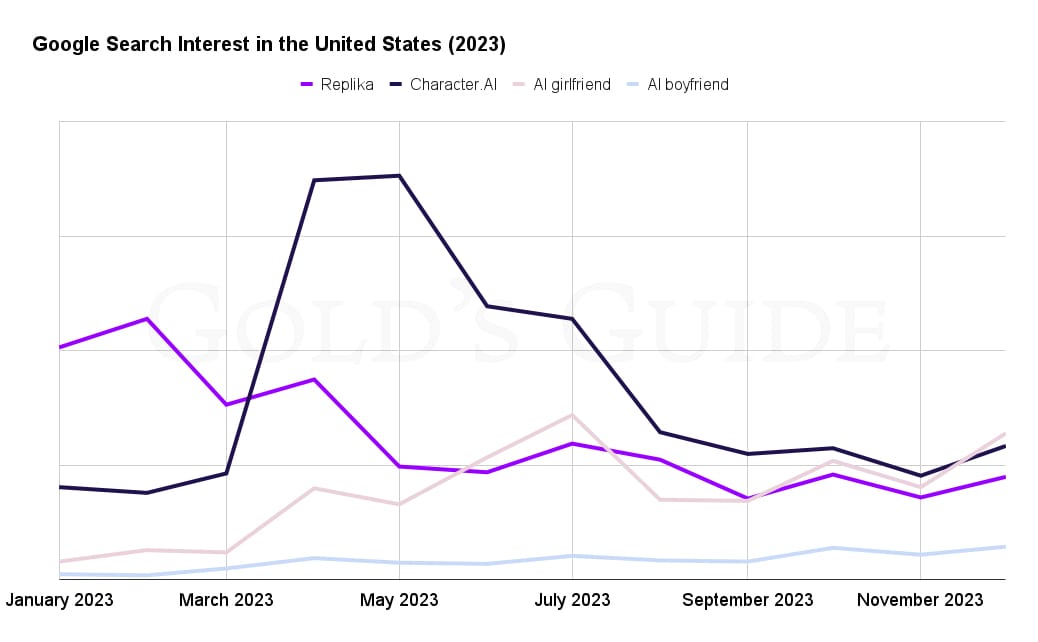
Now that OnlyFans has done the hard work of making artificial companionship socially acceptable, AI chatbots have a clear runway to take advantage of the same exact business that killed the 1-900 number: phone sex taken to the nth degree.
Themes to Watch
- Companions vs. Assistants
- Artificial vs. Organic
- Scaled vs. Intimate
Companions vs. Assistants
Parasocial relationships are not new, but they are becoming more common as time and technology progress. Some people will be more susceptible to the temptations of the internet than others, and many will turn to artificial companions as the path of least resistance.
Innovators will prefer to spend their time interacting with artificial assistants such as ChatGPT, Claude, Microsoft Copilot, Perplexity, and Google Gemini, among others. Instead of serving as a source for contentment like Pygmalion’s Statue, these artificial assistants are like having access to your own army of robots who are constantly ready to help you accomplish your goals.
AI tools are growing increasingly capable for research and have become surprisingly efficient at summarizing and even transposing large swaths of text.
They can also create stunning images in an instant (every one of the images in this article were made with ChatGPT Plus) and can even offer significant corrections (I mistakenly called Ovid a Greek poet in an early draft and ChatGPT politely reminded me; he was Roman).
Artificial vs. Organic
It’s easy imagine a world where people look down upon anyone in a relationship with a robot.
Then again, dating apps were weird at first, and in 2023 Pew Research reported that 53% of Americans younger than 30 have used one. Similarly, anyone who doesn’t have a smartphone or at least an email address in 2024 is essentially living off the grid.
The sci-fi worlds of Neal Stephenson’s Snow Crash and Mike Pondsmith’s Cyberpunk 2077 each imagine polar opposite versions of our future with regards to public acceptance of the artificial vs. the organic.
Those familiar with Snow Crash know it as the book that coined the term “metaverse” back in 1992. Most of the characters in Snow Crash apply digital dualism to the metaverse, similar to how we view a physical room: you’re either there, or you’re not. But “gargoyles” are different: these are people who have completely integrated themselves into cyberspace.
The gargoyles of Snow Crash aren’t full-fledged cyborgs like those depicted in Cyberpunk 2077 — but they do always wear VR goggles to stay tuned into the virtual world. They also carry a bulky array of electronic equipment to record data about the world around them. In Snow Crash, gargoyles are social outcasts caught between two realities: they’re so connected with the metaverse that they completely isolate themselves from physical interactions. Basically, they’re glassholes.
Cyberpunk 2077 portrays an entirely different reality. In that universe, cybernetic enhancements aren’t just normalized; they’re a social standard. People who aren’t “chipped up” in the dangerous world of Cyberpunk are viewed as a weak cut of meat. People visit “ripperdocs” to have new “chrome” installed, often in depraved and unsanitary environments, but they gain superpowers as a result.
The raw power and potential of these implants comes with more than just a financial cost: as people replace more of their bodies with cybernetic parts, they risk losing their humanity in more ways than one. Cyberpunk calls this cyberpsychosis: a complete mental disconnect from empathy and human emotion. These dangerous “cyberpsychos” are portrayed as violent and extremely unstable, and stories in the Cyberpunk universe frequently focus on confronting or otherwise dealing with people who have been driven insane by overexposure to technology.
Intimate vs. Scaled
Like the rest of the creator economy, OnlyFans follows a power law dynamic where the top performers take the majority of the earnings.
In 2020, Tom Hollands scraped OnlyFans to get an idea of the platform’s economics. Perhaps unsurprisingly, he found it “follows a classic power law distribution.”
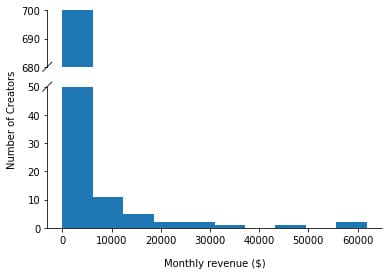
The top accounts make something like $100,000 a month (these aren’t in my sample). The median account makes $180 a month.
The top 1% of accounts make 33% of all the money. The top 10% of accounts make 73% of all the money.
This means that the overwhelming majority of creators on the platform earn next to nothing, and the top 0.1% of creators on OnlyFans — who always have pre-existing parasocial audiences — take home the life-changing money. Again, Hollands:
The standard way to measure inequality of an economy is with a Gini Index. An index of 0 implies a communist utopia, a value of 1 implies a single greedy capitalist owns all the wealth. The Gini index of OnlyFans is 0.83. The most unequal society in the world, South Africa, has a Gini index of 0.68. OnlyFans is less equal than an ex-apartheid state.
Brands that can cultivate parasocial relationships with large audiences will be able to further increase these power-law dynamics in this winner-take all scenario.
The creator economy — which once provided access to opportunities never before seen in the entertainment industry — is increasingly resembling the very system it once competed with.
Tyler’s Take
Now that many of our interactions with other humans are through screens, perhaps an updated version of digital dualism will come into style. While the vast majority of people have embraced the internet — and some are beginning to enter the metaverse — there will always be a counter-narrative that inspires trends like the flip phone becoming a status symbol.
Most people will look for a healthy medium. The smartphone isn’t going anywhere, but we can expect to see even more devices that bring the online and the offline closer together. Humane’s Ai Pin and the Ray Ban x Meta Smart Glasses are just the start; we’ll see even more startups attempting to enter this burgeoning market in 2024.
OpenAI’s GPT Store, which launches this coming week, could present an ocean of new opportunities for people looking to build artificial companions and assistants alike. With Sam Altman back at the helm and the company’s future secure, OpenAI is positioned to double down on ChatGPT’s popularity and launch the first real app store for specialized AI models.
Right now it’s relatively difficult to train a custom AI model on your own content. OpenAI might make it more accessible, but this will likely take place within a walled garden. Conversely, only established brands currently have access to the resources required to download and organize a comprehensive enough archive of everything they’ve ever published to fine-tune a functional AI model.
As more of the top content creators start generating their own procedurally generated shows, existing power-law inequality effects will become even more drastic — at least until digital cloning proliferates to the masses.
If there aren’t already companies working to provide something like “digital cloning as a service”, soon there will be a swarm of startups aimed at capitalizing on this trend. Any creator who has a sufficiently sized content corpus will be able to pay to create their own digital clone.
In the near future, everyone will be able to interact with a perfectly lifelike version of their ideal artificial companion — no blessing from Aphrodite required.
